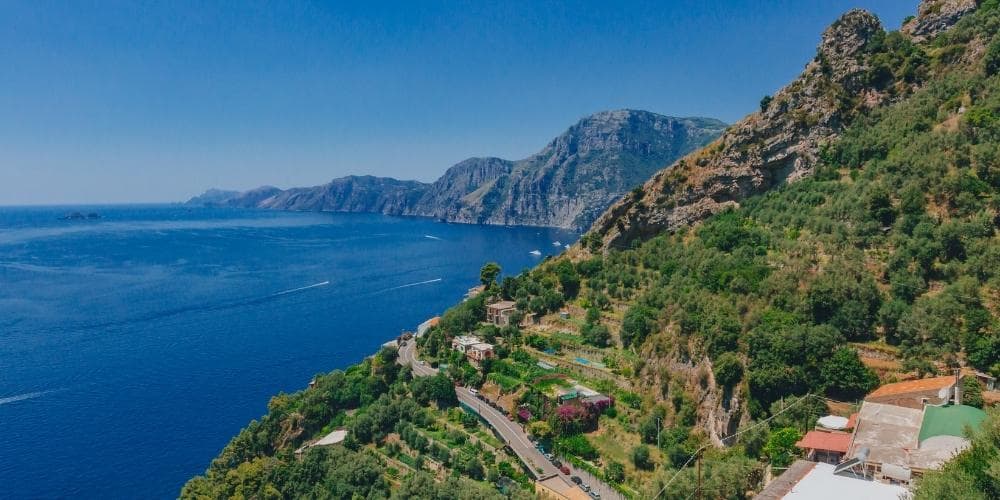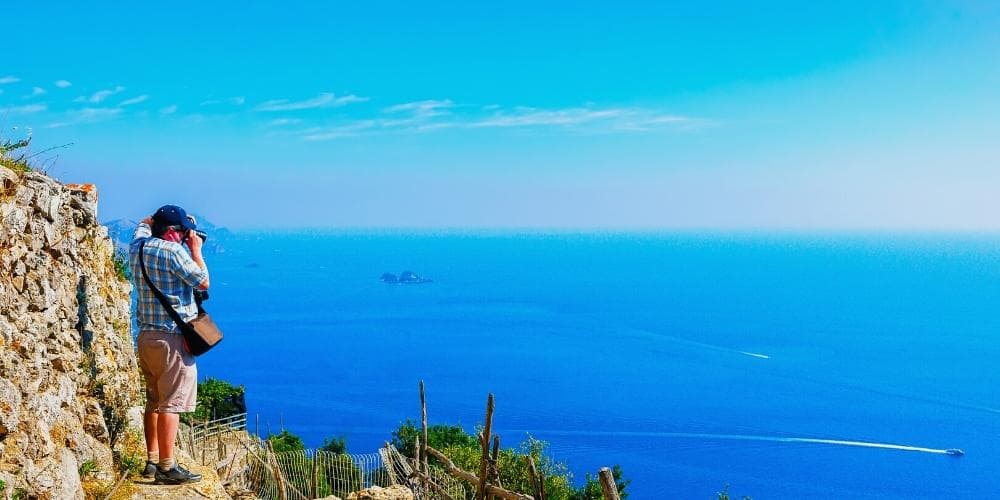The Path of the Gods, il Sentiero degli Dei, is one of Italy's most beautiful nature trails. Definitely, a must-go when you are travelling the Amalfi Coast.
You walk over the Mediterranean Sea, immersed in the breathtaking nature of the Monti Lattari and the fantastic view of the coast. Here is what you need to know to enjoy a unique and unforgettable 600-metre-high experience.

A legendary name...
The Sentiero degli Dei is a magnificent mountain itinerary in the Amalfi Coast that links Bomerano, a subdivision of Agerola, to Nocelle (Positano). Back in ancient times, it used to be the main link between the small towns in the area.
Today, this trail suspended over the sea is best known as a hiking and trekking route.
As is often the case for Italy's destinations, a name is not just a name. There is always a legend explaining the origins and roots of a place, and the Path of the Gods is no exception.
The myth goes that the gods crossed the Monti Lattari to rescue Ulysses from the bewitching Sirens near the Li Galli archipelago (you may have already seen that dolphin-like islet). The deities then forged an authentic itinerary with their footsteps; the same "sentiero" is now walked by thousand of recreational walkers.
The Path of the Gods conjures up epic scenarios from its name, which is no misnomer. But most of all, what is mythical and legendary here is the drop-dead radiant beauty.
What you need to know about the the Path of the Gods

The Path of the Gods stretches for 9 km from Agerola to Positano. In three, four hours you'll get from one side to the other. On the way back, you can decide whether to resume hiking or reach Amalfi by bus or ferry and continue to Bomerano by bus.
There are two ways to choose. The first walk is softer and offers breathtaking views of the Amalfi Coast without involving excessive climbings, just some minor undulations. The second way takes you to 1079-metre high Capo Muro. Given the greater altitude, this last sentiero alto is more complex and demanding: opt for the first route, the sentiero basso, if you are out of practice.
The Path of the Gods is an itinerary that doesn't feature any challenging sections and is within everyone's reach. Anyway, it may not be for you if you suffer from vertigo. We are talking about a path overhanging the sea, with some stretches without protection and therefore exposed to the void. Keep this detail in mind even if you are travelling with small children. Also, the track is not suitable for strollers.
Do not be fooled by the location. The Amalfi Coast is indeed famous for its dreamscapes that smell of sea and relaxation, but the Sentiero degli Dei is a mountain hike in its own right. Put aside your sandals and flip-flops and opt for more appropriate hiking shoes.
Although it is accessible (and free) all year round, spring and early autumn are the best times to walk the Path of the Gods, if only to avoid excessive heat and the risk of rain and strong winds.
You can do it on your own following the sign cartels or booking a guided tour with an expert to have a more complete and satisfying experience.
The Path of the Gods - from Agerola to Positano
The starting point is in Agerola. If you do the Path of the Gods in the summer, start early in the morning to avoid walking during the hottest hours.
Also, consider booking accommodation in the area. You'll find several facilities to reach the trail comfortably on foot, such as the Bed & Breakfast La Cascina, a short stroll from the outset in Via Casalone. There is also another access to the path placed in Piazza Paolo Capasso in Bomerano.
A breathtaking view

Step by step, you enter a scenario that preserves all the charm of a truly legendary land. With a little imagination, can almost hear the sirens' song or the imperious steps of the Olympians at every breath of wind.
The Amalfi Coast puts your legs and breath to the test, with climbs and steps that can give visitors a hard time. However, the Path of the Gods is one of the few itineraries in the area where you won't have to climb inordinate amounts of steps.
You walk among rosemary, thyme and myrtle scents, passing through vineyards, wild wooded glimpses and vertiginous terraces overlooking the Tyrrhenian Sea.
Farmers with a donkey in tow carrying baskets of garden products are a common sight. Locals still use the route to reach the tiny hamlets of the surrounding area.
The first point of interest is the Grotta del Biscotto, a cave that owes its name to the typical bread of Agerola. The remains of an ancient and mysterious rocky village suspended fearfully in the void stand nearby.
Further on, stone steps lead to one of the most photographed views of the Sentiero degli Dei. It is a curious limestone tower called "Pistillo".
Not far from this singular rock pinnacle, the main walk divides into sentiero alto (high path) and sentiero basso (low path) around Colle Serra.
You can make a diversion to the Convent of San Domenico, admire its medieval frescoes and catch your breath on the terrace with Capri on the horizon.
Caves, water springs, old farmhouses, crop terraces and vegetable gardens frame the landscape as you meander down to Nocelle. Stop in the piazzetta and enjoy a granita in the company of the friendly cats of the square.
Some hikers elect to get to Montepertuso for a closer look at the unusual attraction to which this subdivision of Positano owes its name. You'll find yourself in front of a rock wall with a big hole in the middle ("pertuso" in the Neapolitan dialect). It almost looks like a gash made on purpose.
Legend has it that the Virgin Mary pierced the rock during a clash with the devil.
Take your photos, head to the Chiesa di Santa Maria delle Grazie, and carry on down the stair (yet another one!) to Positano.
Agerola, where the Path of the Gods begins

It towers 600 metres above the Amalfi Coast's sea and can be tremendously appealing for hikers and Campanian cuisine lovers.
Agerola is a perfect "base camp" for outdoor enthusiasts. Spectacular and adventurous treks start here. The Path of the Gods indeed is just one of the hiking trails to venture in. You walk on the same routes once marked by the flourishing trade that revolved around the Duchy of Amalfi.
Valle delle Ferriere is another itinerary that will win you over. Following old mule tracks, steep slopes, waterfalls and hidden paths, you will first reach a Nature Reserve where a rare Tertiary Era fern grows and then the ruins of the ancient ironworks and paper factories of the Valle dei Mulini.
Agerola features some points of interest to stop by between one excursion and another. The Museo Etnoantropologico tells the story of this fascinating territory through an interesting collection of archaeological finds. The ruins of the Lauritano Castle are in a perfect spot to appreciate one of the best views in town. Also enjoy the splendid panorama from the Parco Corona in the subdivision of Campora.
As for local cuisine, Agerola's culinary tradition is as rich as ancient. As early as the 13th century, it supplied the court of Naples with hams, salami, sausages and lard. Before leaving, stock up on taralli and try the famous Fiordilatte and Provolone del Monaco Dop.
How to get to the Path of the Gods
From Naples, drivers can take the A3 motorway to the Castellammare di Stabia exit, continue towards Gragnano/Lettere/Agerola/Amalfi and then take the SS 366 towards Agerola.
Parking near the Sentiero degli Dei is not always easy. You will find a small parking space in the centre of Bomerano. Alternatively, leave your car in the car park near the stadium.
In general, driving around the towns of the Amalfi Coast can be difficult for those who are not used to curves, hairpin bends and narrow roads.
You can always opt for public transport and take a SITA bus from Naples and Amalfi. Those coming from Positano and Sorrento can easily reach Amalfi by bus and continue to Agerola from there.
About the author
Written on 11/05/2022




Lorena Calise
Find out everything you need to know about the most sensational walk on the Amalfi Coast. Here is why you shouldn't miss it.